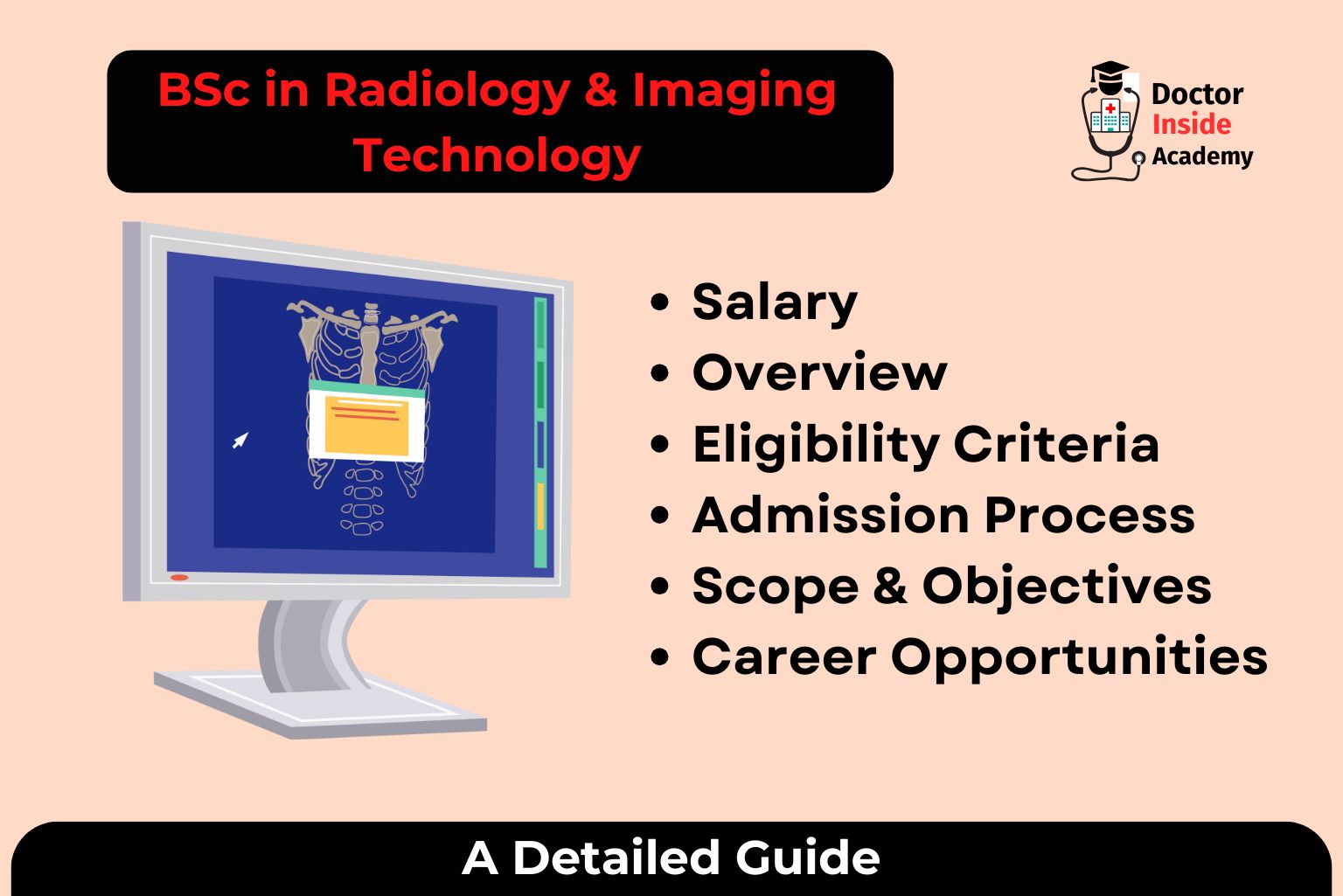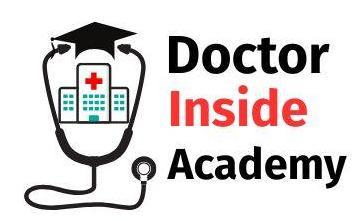
BSc in Radiology and Imaging Technology
Duration
3 Years
Level
Under Graduation
Mode
Offline/Full Time
Overview of B Sc Radiology and Medical Imaging Technology
B Sc in Medical Imaging Technology is a 3-year undergraduate course program with the extension of a 6-month practical internship. The student gains a fundamental understanding of human anatomy, physiology, disease, and medical imaging methods and technology like X-ray, radiation protection, patient safety, and management with effective communication, Computed Tomography (CT), Magnetic Resonance Imaging (MRI), etc.
- Medical Radiology is the science of capturing images of the internal and hidden portions of the human body for diagnostic purposes using ultrasound, X-ray, CT scan, MRI, etc. B Sc Radiology and Medical Imaging Technology, the best paramedical professional course, is designed to create professional technicians in the radiology department, which deals in medical imaging and diagnostics with the help of ionizing and non-ionizing radiation.
- A bachelor's degree in radiation imaging technology requires academic and practical knowledge to succeed in radiology, making your career successful. Students who complete this educational program can pursue a highly profitable profession as a radiologic technologist in hospitals and clinics, or can open their own radiodiagnostics lab.
- Radiology and imaging technology are two of the most effective career options for people interested in the medical field who have not passed the NEET exam. This is the direct way to enter this field.
Radiology is an emerging medical science field with many career opportunities in private and government hospitals or nursing homes. This course is already occupied with theory and practical sessions effectively.
Duration of BRIT Course
- The average duration of a BSc RIT course is 3 years + 1 Year Internship/ 6 Months.
B Sc Radiology and Medical Imaging Technology Course Includes
- A detailed theoretical and practical process to understand human anatomy and physiology. Understanding the uses and operating procedure of the radiography equipment, maintenance, and proper radiation quality control training.
- For hands-on experience in radiology and imaging technology, you will have an internship in hospitals and clinics to get real-time exposure to patient handling and learn about the functionality of machines.
- Many imaging modalities, including X-rays, nuclear medicine, CT (Computerized Tomography), MRI (Magnetic Resonance Imaging), and ultrasound, will be taught in your academic classes.
- They also understand image interpretation, patient placement, radiation safety and protection, and the different applications of imaging technologies for medical condition diagnosis.
BSC RIT Details
# | Details |
B Sc Radiology and Medical Imaging Technology Level | Undergraduation |
B Sc Radiology and Medical Imaging Technology Duration | 3 Years |
B Sc Radiology and Medical Imaging Technology Fees | Average INR 25,000-80,000(Per Semester)* |
B Sc Radiology and Medical Imaging Technology Admission Criteria | Generally, Merit-Based |
B Sc Radiology and Medical Imaging Technology Eligibility Criteria | 12th with PCB (Physics, Chemistry, Biology) |
B Sc Radiology and Medical Imaging Technology Job Profiles | Radiographers, Mammographers, MRI or CT Technologists, etc. |
B Sc Radiology and Medical Imaging Technology Salary | Average Salary INR 2.4 to 8 Lakhs* |
- *Note - It's an educational data only, real-time data may be differ from the given value here. So please verify that first.
B Sc Radiology and Medical Imaging Technology Eligibility Criteria
The eligibility criteria for a BSc in Radiology and Imaging Technology vary slightly depending on the university or institution.
Here is the general eligibility for BSc RIT courses, commonly found across universities and colleges:
- Candidates must pass out from 12th in the Science stream with Physics, Chemistry, and Biology subjects, or a Diploma in Medical Radiology and Imaging Technology after completing 10th class/ 10 +2 of CBSE or equivalent with a minimum aggregate of 50% marks in Physics, Chemistry, and Biology, provided the candidate has passed in each subject separately.
- Candidates must have scored at least 50%.
- At the time of admission, candidates must be at least 17.
Any student who wants to get into B.Sc in Radiography and Medical Imaging must be passionate about this course because their performance should reflect their interests.
Provision of Lateral Entry
Lateral entry to the second year of BSc medical and imaging technology for candidates who have passed the diploma program from the Government Boards and recognized by the State/Central University, fulfilling the conditions specified, and these students are eligible to take admission on the lateral entry system only if the same subject has been studied at the diploma level.
BSc RIT Admission Process
Fill out Our Enquiry Form
Profile Evaluation by Experts
Get a Call Back from Our Counsellors
Scope & Objectives of BSc Radiology and Imaging Technology
Radiology is evolving, and many new advancements are taking place to make more advanced diagnoses, etc., so BSc RIT has a wide range of Scope to build a career in it.
Here is a list of the Scope and objectives of BSc Radiology and Imaging Technology:
- It helps in building a profession and community with skilled, experienced technologists.
- Deliver an in-depth educational curriculum that boosts problem-solving, critical thinking, communication skills, Ethics, and accountability at all levels (clinical, professional, personal, and social).
- Understanding the clinical environment and patient needs.
- Students also learn patient care skills, including professionalism and medical and radiology ethical conduct as a discipline methodology.
- Graduate students can easily secure jobs in the initial days after graduation.
- To boost knowledge about clinical education focusing on problem-solving and critical thinking.
- To create a sense of care and compassion among students committed to providing highly efficient patient care services.
- Meet the increasing demand for medical imaging technologists.
- To create a sense of care and compassion among students committed to providing highly efficient patient care services.
- Strengthening communication skills and empathy for patients, families, and other healthcare providers.
- To create professionals with the highest clinical competency.
Syllabus of B Sc Radiology & Medical Imaging Technology
The program’s curriculum is designed to provide a comprehensive understanding of radiology and imaging technology.
Here is an overview of the course content:
- Human Anatomy & Physiology
- General Physics
- Radiation Physics
- Radiological Pathology
- Physics of Diagnostic Radiology
- Radio Diagnosis Equipment, Maintenance, and Quality Control
- X-Ray Positioning
- Clinical Radiography
- Contrast Procedures
- Dark Room Techniques
- X-ray Film / Image Processing Techniques
- Contrast & Special Radiography Procedures
- Personality Development, Customer Relationship Management & Grooming
- Medical Ethics
- Quality Control in Radiology
- Radiobiology & Radiation Safety
- Equipment of modern Imaging Modalities
- Modern Imaging Techniques and Recent Trends in Imaging
- Interview & Group Discussion Skills, Change & Stress Management
- Basics of Hospital Information System (HIS) - Medical Software Applications
Career Opportunities of B Sc Radiology & Medical Imaging Technology
Radiology students can pursue higher and better career opportunities. When the course has been completed, the potential candidates, with their skill set and aptitude scores, can enter different career paths.
Graduates of the B.Sc. in Medical Radiology Imaging Technology program can pursue various rewarding career paths:

Mammography Technologist

Radiology Technologist

Teaching Associate

MRI
Technician

CT Scan
Technician

Sales and Service of Radiology Equipment

University Research Laboratory

Radiation Safety Officer

Radiology Assistant
BSc in Radiology and Imaging Technology Salary in India
Experience, location, and the type of healthcare organization are some variables that affect a BSc Radiology and Imaging Technology graduate’s salary in India.
In addition to the BSc in Radiology and Imaging Technology pay in India, candidates get a glance at the following job profiles:
Job Profiles | Description | Average Salary* |
Radiographers | Perform diagnostic images, like X-ray, CT, and MRI | INR 3.5LPA* |
MRI Technician | Operates MRI machines to produce in-depth human body images | INR 4LPA* |
CT Technician | Who operates the CT Scan machine and produces cross-sectional images of the human body | INR 3.4LPA* |
Mammographers (Female Preferred) | Perform female imaging commonly | INR 3.2LPA* |
Teaching Faculty | Who teaches paramedical students in colleges or universities | INR 4LPA* |
Own Diagnostics Lab | You can start your radiology diagnostic under all guidelines | INR 2-10 LPA* |
*Note – It depends on many factors; it’s an average metric shown here, for educational purposes only. Real-time statistics can vary from time to time and demand.
Get Free Counselling
FAQ BSc Radiology & Imaging Technology
To pursue a BSc in Radiology and Imaging Technology, students must have completed the 12th with PCB/PCM, with a minimum score of 50%. At admission, the student’s age must be above 18 or above.
B.Sc in Medical Imaging Technology (B.Sc MIT) is a 3 to 4-year UG program that focuses on diagnostic imaging techniques, like X-rays, CT scans, MRIs, etc, used in healthcare to detect and diagnose diseases.
You will learn all these aspects: X-ray & Radiographic Techniques, MRI (Magnetic Resonance Imaging), CT Scan (Computed Tomography), Ultrasound & Doppler Imaging, Radiation Safety & Protection, Clinical Training in a Hospital.
After completing a B.Sc in Medical Radiography and Imaging Technology, a passed-out student can become a radiology technician, CT technologist, Nuclear Medicine Technologist, Radiation Therapist, Radiographer, Radiology administrator, Medical sonographer, Radiology assistant, and Radiology researcher.
Initially, students may expect a salary package of approximately 1.5 LPA as a Radiology staff, which can increase to approximately 3.5 LPA with your destination as a Radiology Assistant. They can make more money as an ultrasound technician, with an average compensation package of 6 LPA. The degree level that a student completes decides the pay expectation, based on their experience in the radiology diagnostic centres.
Some top employers for B.Sc in Medical Radiography and Imaging Technology students include well-known hospital brands such as Apollo Hospitals, Fortis Hospitals, AIIMS, Dr Reddy’s Pathlabs, and Padma Shree Diagnostic Center. Even government hospitals regularly hire B.Sc. in Medical Radiography and Imaging Technology students, where they can get a ton of practical experience.





